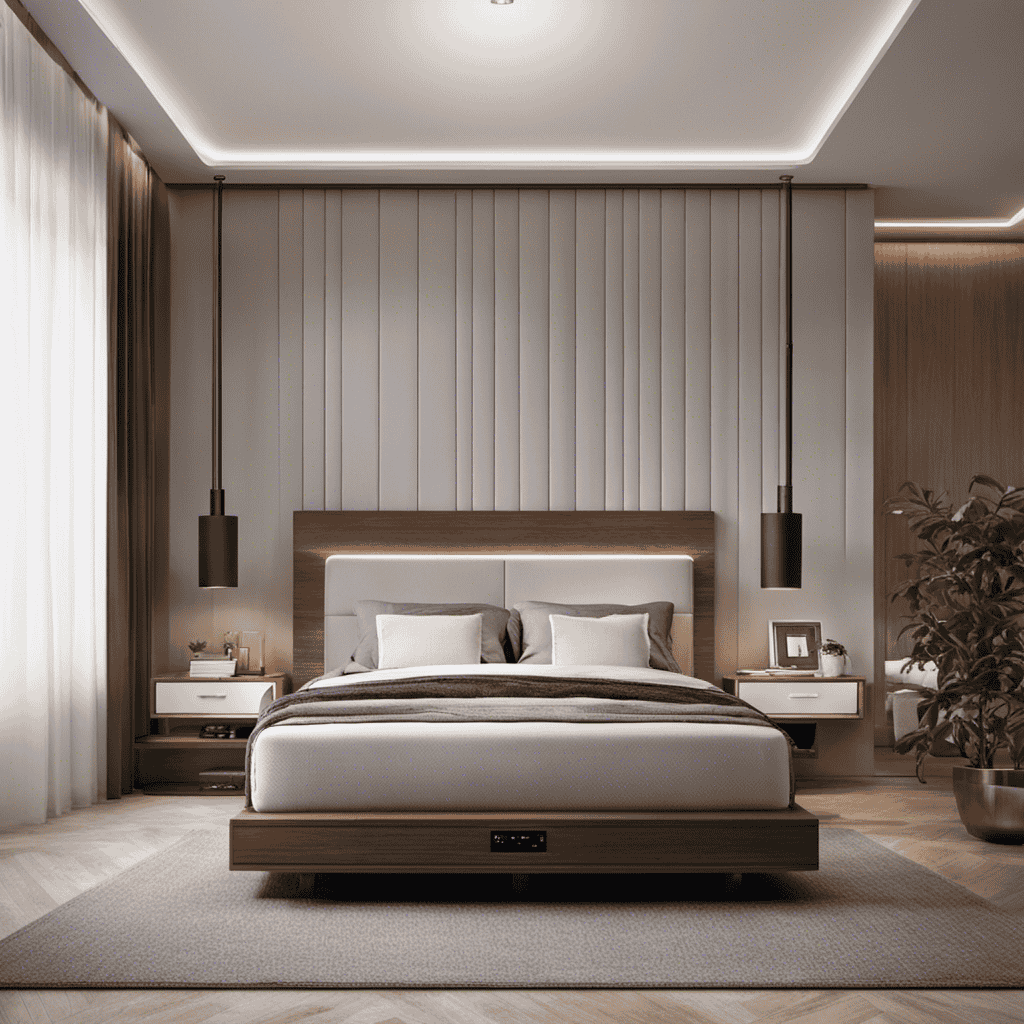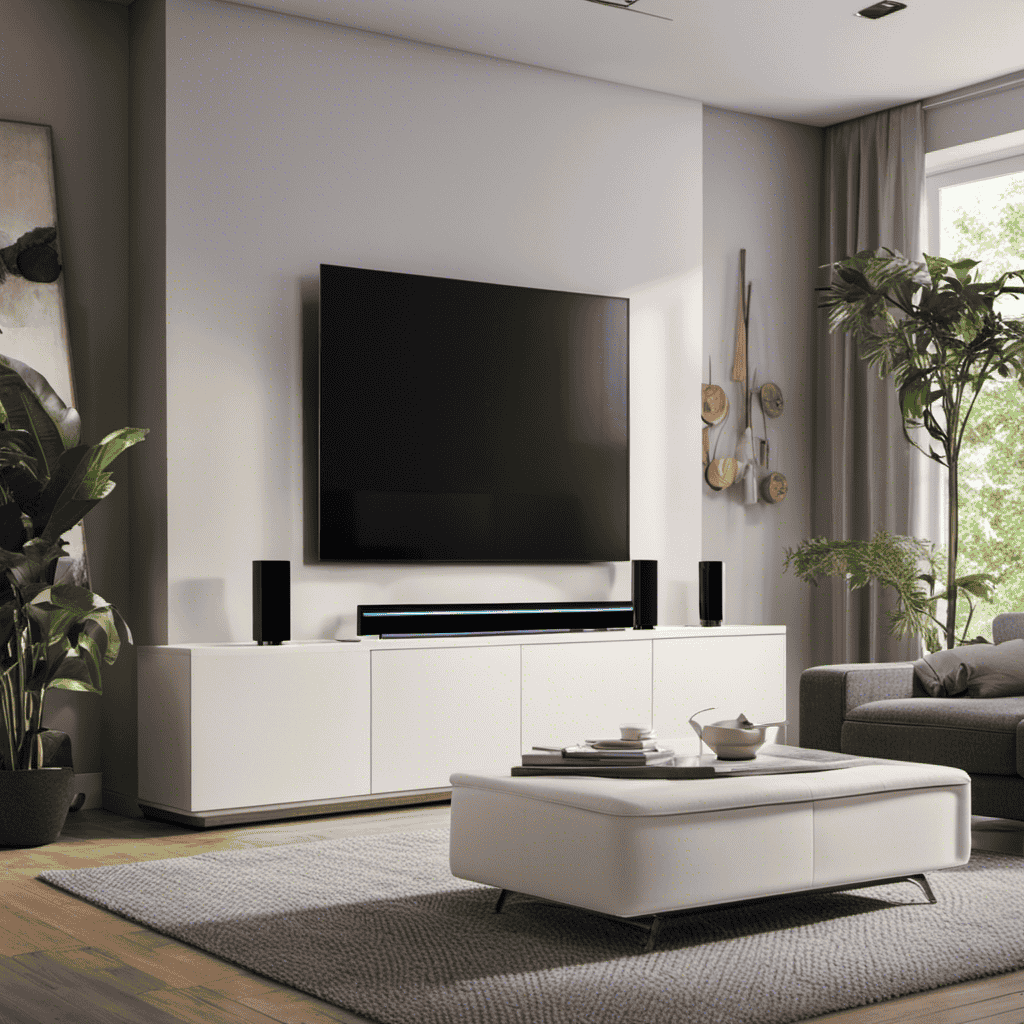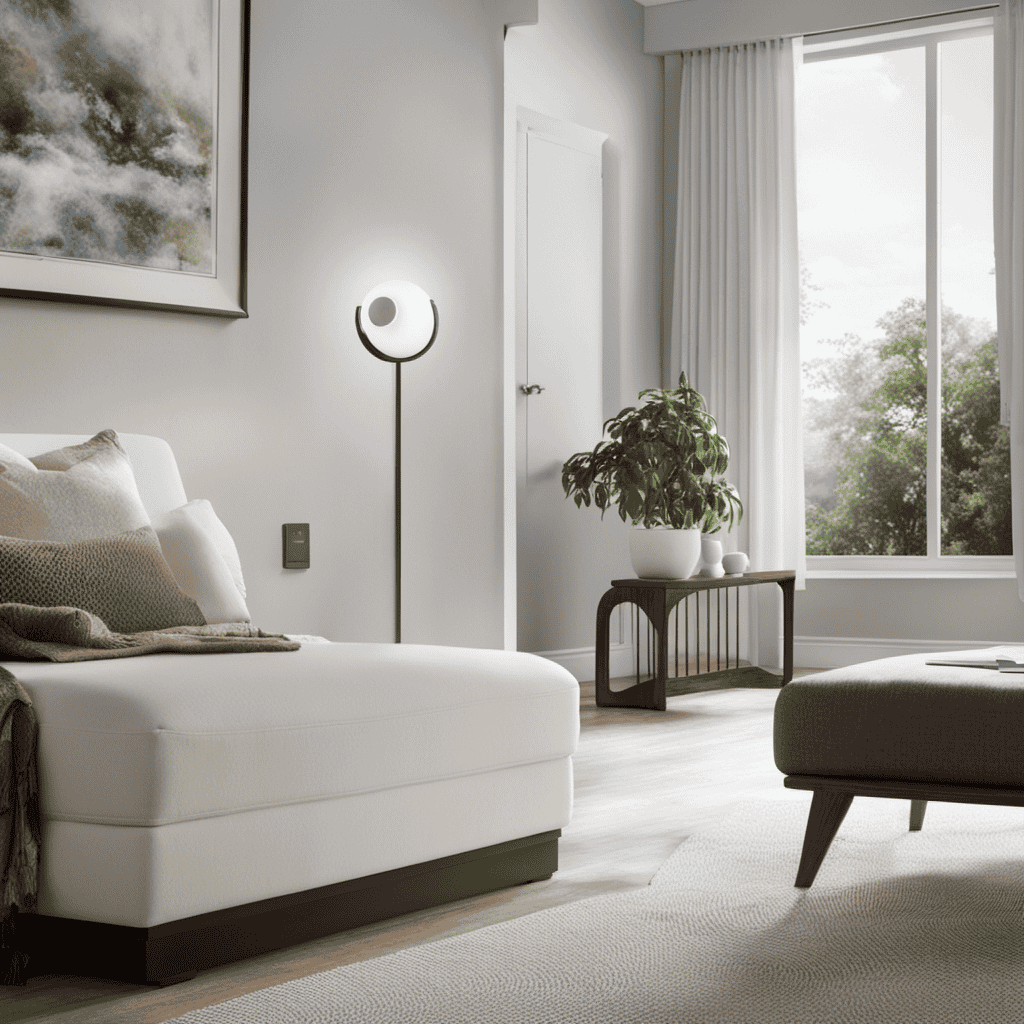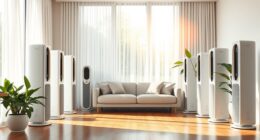As a dedicated researcher and someone who prioritizes having clean air in my home, I have often pondered, ‘What does an air purifier actually do?’
In this article, we will delve into the world of air purification, exploring the importance of clean air, how air purifiers work, and the benefits they can bring to your life.
So, let’s clear the air and uncover the truth about air purifiers and the role they play in improving indoor air quality.
Key Takeaways
- Air purifiers remove pollutants and allergens from the air, improving air quality.
- Breathing clean air reduces the risk of respiratory problems, allergies, and asthma attacks.
- Air purifiers use different types of filters and technologies to capture and remove pollutants.
- Indoor and outdoor air can both contain harmful pollutants, and understanding the differences can help make informed decisions about improving air quality.
The Importance of Air Purification
Air purifiers are important because they help remove pollutants and allergens from the air you breathe. Maintaining good air quality is crucial for our overall health and well-being.
Breathing clean air has numerous benefits, such as reducing the risk of respiratory problems, allergies, and asthma attacks. Polluted air can contain harmful particles like dust, pollen, pet dander, mold spores, and even volatile organic compounds (VOCs) from household products. These pollutants can exacerbate existing health conditions and contribute to the development of new ones.
How Air Purifiers Work
To understand how an air purifier works, you’ll want to start by knowing how it filters and cleans the air in your environment. Here’s a breakdown of the process:
-
Air purifier filters: These devices use different types of filters to capture and remove pollutants from the air. The most common types of filters include HEPA filters, activated carbon filters, and electrostatic precipitators. HEPA filters are highly effective at trapping small particles like dust, pollen, and pet dander, while activated carbon filters are great at adsorbing odors and gases.
-
Air purifier technology: Air purifiers use various technologies to enhance their filtration capabilities. Some models use UV-C light to kill bacteria and viruses, while others use ionizers to charge particles and make them easier to capture. Additionally, some advanced air purifiers have sensors that monitor air quality and adjust their settings accordingly.
-
Air circulation: Air purifiers work by drawing air from the room through their filters and then releasing the purified air back into the environment. This continuous circulation helps to remove pollutants and improve indoor air quality.
Understanding how air purifiers filter and clean the air is crucial in assessing their effectiveness in improving air quality.
Now let’s delve into the next section and explore the factors that contribute to understanding air quality.
Understanding Air Quality
When it comes to understanding air quality, it’s important to consider the health effects of pollution, both indoors and outdoors.
Pollution can have a significant impact on our well-being, leading to respiratory problems, allergies, and other health issues.
However, by focusing on the benefits of clean air and taking steps to improve air quality, we can create a healthier environment for ourselves and future generations.
Health Effects of Pollution
Breathing in polluted air can negatively impact your health. It’s important to understand the health risks associated with long-term exposure to air pollution. Here are three key things to know:
-
Increased risk of respiratory diseases: Long-term exposure to air pollution can lead to the development or worsening of respiratory conditions such as asthma, chronic bronchitis, and even lung cancer. Fine particulate matter and toxic gases present in polluted air can irritate the airways, cause inflammation, and damage lung tissues.
-
Cardiovascular problems: Air pollution has been linked to an increased risk of cardiovascular diseases, including heart attacks, strokes, and high blood pressure. The harmful pollutants in the air can enter the bloodstream, leading to the formation of plaque in the arteries and causing inflammation, which can contribute to heart problems.
-
Reduced lung function: Prolonged exposure to polluted air can result in a decline in lung function over time. This means that your lungs may not be able to take in as much oxygen or expel carbon dioxide effectively, leading to shortness of breath, decreased physical endurance, and a decreased quality of life.
It’s crucial to protect yourself from the harmful effects of air pollution by taking measures to improve air quality, such as using air purifiers or avoiding heavily polluted areas.
Indoor Vs. Outdoor Air
If you’re concerned about the quality of the air you breathe, it’s important to understand the difference between indoor and outdoor air. Indoor air refers to the air inside buildings, such as homes, schools, and offices, while outdoor air refers to the air outside these structures. Both indoor and outdoor air can contain pollutants that can have negative effects on our health. However, the types and levels of pollutants can vary between the two environments.
To compare the air pollutants in indoor and outdoor air, let’s take a look at the table below:
| Indoor Air Pollutants | Outdoor Air Pollutants |
|---|---|
| Volatile Organic Compounds (VOCs) | Particulate Matter (PM) |
| Carbon Monoxide (CO) | Nitrogen Dioxide (NO2) |
| Formaldehyde | Ozone (O3) |
As you can see, indoor air pollutants such as VOCs and formaldehyde mainly come from sources like cleaning products, furniture, and building materials. On the other hand, outdoor air pollutants like PM and NO2 are primarily caused by vehicle emissions, industrial activities, and natural sources. Understanding the differences between indoor and outdoor air pollutants can help you make informed decisions about improving the air quality in your living or working environment.
Benefits of Clean Air
To fully understand the benefits of clean air, you should be aware of how it can improve your overall health and well-being. Breathing in clean air is essential for maintaining good respiratory health. Here are three ways that clean air can benefit you:
-
Reducing the risk of respiratory illnesses: Clean air helps to remove pollutants and irritants from the air, reducing the risk of developing respiratory illnesses such as asthma, bronchitis, and allergies.
-
Improving lung function: Breathing in clean air allows your lungs to function optimally, enabling better oxygen intake and carbon dioxide removal. This can lead to improved lung capacity and overall respiratory health.
-
Minimizing allergy symptoms: Clean air helps to reduce the presence of allergens such as pollen, dust mites, and pet dander. This can alleviate allergy symptoms such as sneezing, itching, and congestion.
Common Airborne Contaminants
Air purifiers can remove common airborne contaminants such as dust, pollen, and pet dander. These contaminants are often the culprits behind airborne allergies, causing symptoms like sneezing, coughing, and itchy eyes.
Air pollution sources, both indoor and outdoor, contribute to the presence of these contaminants in the air we breathe. Indoor sources include tobacco smoke, cleaning products, and mold, while outdoor sources include vehicle emissions and industrial pollutants.
These contaminants can easily enter our homes through open windows, doors, and even on our clothes and shoes. Air purifiers work by using filters to capture these particles and prevent them from circulating in the air.
High-efficiency particulate air (HEPA) filters are particularly effective in removing particles as small as 0.3 microns, ensuring cleaner and healthier air for everyone in the household.
Benefits of Using an Air Purifier
Using an air purifier can greatly improve indoor air quality and reduce the presence of common airborne contaminants. Here are three key benefits that an air purifier can provide for allergy sufferers and their impact on respiratory health:
-
Allergen Removal: Air purifiers are designed to remove allergens such as dust mites, pollen, pet dander, and mold spores from the air. By filtering out these particles, they can significantly reduce the triggers for allergies and asthma.
-
Improved Breathing: Air purifiers can effectively remove harmful pollutants like smoke, chemicals, and volatile organic compounds (VOCs) from the air. This helps to create a cleaner and healthier environment, making it easier for individuals with respiratory conditions to breathe.
-
Reduction of Odors: Air purifiers equipped with activated carbon filters can effectively trap and eliminate odors from cooking, pets, and other sources. This not only improves the overall air quality but also creates a more pleasant living space.
By providing these benefits, air purifiers can have a positive impact on the respiratory health of individuals, especially those with allergies and respiratory conditions.
Transitioning into the subsequent section, let’s now explore the different types of air purifiers available in the market.
Different Types of Air Purifiers
Now that we know the benefits of using an air purifier, let’s delve into the different types available in the market.
Air purifiers come in various models, each designed to target specific pollutants and allergens. One important component of an air purifier is the filter. There are different types of filters used in air purifiers, such as HEPA filters, activated carbon filters, and electrostatic filters.
HEPA filters are highly effective at capturing airborne particles as small as 0.3 microns, including dust, pollen, pet dander, and mold spores. Activated carbon filters are great for removing odors and chemicals from the air. Electrostatic filters use an electric charge to attract and trap particles.
When choosing the best air purifier for your needs, consider the types of filters it uses, as well as the size of the room you plan to use it in.
Choosing the Right Air Purifier for Your Needs
When it comes to choosing the right air purifier for your needs, there are several key considerations to keep in mind.
Firstly, you’ll want to think about the size of the room you’ll be placing the air purifier in, as this will determine the unit’s coverage area.
Secondly, it’s important to consider the specific pollutants you’re looking to remove from your indoor air, whether it’s allergens, smoke, or chemicals.
Lastly, understanding the different effective purification methods available, such as HEPA filtration, activated carbon filters, or UV-C light, will help you make an informed decision on the best air purifier for your needs.
Key Considerations for Air Purifiers
If you’re looking for an air purifier, there are a few key considerations you should keep in mind.
First, think about the specific features you need. Some air purifiers come with HEPA filters, which are highly effective in removing airborne particles like dust, pollen, and pet dander. Others may have activated carbon filters, which can help eliminate odors and chemicals.
Second, consider the size of the purifier and the area you want to cover. Make sure the purifier is suitable for the room size to ensure efficient purification.
Lastly, compare prices of different air purifiers. While cost shouldn’t be the sole determining factor, it’s important to find a purifier that fits your budget without compromising on quality.
By considering these factors, you can find an air purifier that meets your specific needs.
Now, let’s explore the effective purification methods.
Effective Purification Methods
To effectively purify the air in your space, consider using methods like HEPA filtration or activated carbon filters.
These methods are highly effective in removing allergens and eliminating odors.
HEPA, or High-Efficiency Particulate Air, filters are designed to capture particles as small as 0.3 microns, including pollen, dust mites, pet dander, and mold spores. This makes it an excellent choice for individuals with allergies or asthma.
Activated carbon filters, on the other hand, are great at neutralizing odors and trapping volatile organic compounds (VOCs) that contribute to unpleasant smells. They work by adsorbing these odorous molecules onto their porous surface.
When used together, HEPA filtration and activated carbon filters can provide a comprehensive solution for purifying the air in your space, ensuring a clean and fresh environment for you and your family.
Maintenance and Cleaning of Air Purifiers
Make sure you regularly clean and maintain your air purifier to ensure optimal performance. Here are three maintenance techniques and troubleshooting tips to help you keep your air purifier in top shape:
-
Change the filters: The filters in your air purifier trap dust, allergens, and other particles from the air. Over time, these filters can become clogged and less effective. It’s essential to replace them according to the manufacturer’s instructions to maintain the purifier’s efficiency.
-
Clean the exterior: Dust and debris can accumulate on the exterior of your air purifier, hindering its performance. Wipe down the surface regularly with a soft cloth or use a vacuum cleaner with a brush attachment to remove any dirt.
-
Check for malfunctions: If your air purifier is not working correctly, check for any loose connections or damaged parts. Refer to the user manual for troubleshooting tips or contact the manufacturer for assistance.
By properly maintaining your air purifier, you can ensure that it continues to provide you with clean and fresh air.
Now, let’s explore some tips for improving indoor air quality.
Tips for Improving Indoor Air Quality
Now that we have discussed the maintenance and cleaning of air purifiers, let’s move on to some tips for improving indoor air quality.
One of the most effective ways to enhance the air we breathe is by improving ventilation. Proper ventilation helps to remove stale air and bring in fresh outdoor air, reducing the concentration of pollutants indoors. Opening windows and using exhaust fans in kitchens and bathrooms can greatly improve ventilation.
Another important aspect of improving indoor air quality is reducing allergens. Allergens such as dust mites, pollen, and pet dander can trigger allergies and asthma symptoms. Regularly dusting and vacuuming surfaces, washing bedding in hot water, and keeping pets out of bedrooms can help reduce the presence of these allergens in your home.
Frequently Asked Questions About Air Purifiers
When it comes to improving indoor air quality, one effective tool to consider is an air purifier.
In this discussion, we will explore the benefits of using an air purifier, how to choose the right one for your needs, and important maintenance tips to keep it running efficiently.
Air Purifier Benefits
Using an air purifier can greatly improve the air quality in your home, reducing allergens and pollutants. Here are three key benefits of using an air purifier:
-
Allergen reduction: Air purifiers are designed to remove common allergens from the air, such as pollen, dust mites, pet dander, and mold spores. These particles can trigger allergies and asthma symptoms, but with an air purifier, you can breathe easier and experience fewer allergy-related issues.
-
Odor elimination: Air purifiers equipped with activated carbon filters can effectively remove unpleasant odors from your home. Whether it’s cooking smells, pet odors, or cigarette smoke, an air purifier can help eliminate these odors and leave your home smelling fresh and clean.
-
Improved respiratory health: By reducing airborne particles and pollutants, air purifiers can improve respiratory health. This is especially beneficial for individuals with allergies or respiratory conditions like asthma, as cleaner air can help alleviate symptoms and reduce the frequency of attacks.
Investing in an air purifier with advanced technology can bring these benefits and provide a healthier living environment, particularly for those with allergies.
How to Choose
To choose the right air purifier for your needs, consider factors like room size, filter type, and noise level.
When it comes to air purifier brands, there are several reputable options available in the market. Some popular brands include Dyson, Honeywell, and Coway. However, it’s important to note that the cost of air purifiers can vary greatly depending on the brand, features, and additional functionalities. While some basic models may be more affordable, high-end air purifiers with advanced filtration systems and smart technology can be more expensive.
It’s essential to determine your budget and prioritize your needs before making a decision.
Now that you have chosen the right air purifier, let’s move on to maintenance tips to ensure its optimal performance.
Maintenance Tips
Now that you’ve chosen the right air purifier, let’s discuss some maintenance tips to keep it running smoothly. Following a proper cleaning schedule is crucial to ensure the effectiveness of your air purifier.
Here are three important maintenance tasks to keep in mind:
-
Regularly clean the pre-filter: The pre-filter is the first line of defense against larger particles. It helps prolong the life of the main filter. Cleaning it every 2-3 weeks will prevent it from becoming clogged and maintain optimal performance.
-
Replace the filters when necessary: Filters are the heart of an air purifier. Different types of filters have different lifespans. It is important to check the manufacturer’s recommendations and replace them accordingly. Generally, HEPA filters should be replaced every 6-12 months.
-
Keep the unit clean: Dust and dirt can accumulate on the exterior and vents of the air purifier, hindering its efficiency. Wiping the unit with a damp cloth and vacuuming the vents regularly will help keep it clean and improve its performance.
Frequently Asked Questions
Can an Air Purifier Remove All Types of Indoor Air Pollutants?
Yes, an air purifier can remove many types of indoor air pollutants. It filters out particles like dust, pollen, and pet dander, as well as odors and harmful chemicals. Using an air purifier has numerous benefits for improving indoor air quality.
How Often Should I Replace the Filters in My Air Purifier?
I replace my air purifier filters regularly to ensure effective air purifying. Signs of a dirty filter include reduced airflow and a musty odor. Proper air purifier maintenance is key for clean and healthy indoor air.
Can an Air Purifier Help With Allergies and Asthma?
Yes, an air purifier can help with allergies and asthma. It filters out allergens and irritants from the air, reducing symptoms and improving air quality. Its effectiveness depends on the specific model and the size of the area it covers.
Do Air Purifiers Consume a Lot of Energy?
Air purifiers can consume varying amounts of energy depending on the model and usage. It’s important to choose an energy-efficient unit to minimize environmental impact. Some air purifiers have low energy consumption and can be left on continuously.
Are Air Purifiers Noisy When Running?
Air purifiers can be noisy when running, but the benefits outweigh the noise. Regular maintenance is crucial to keep them functioning properly. They filter out pollutants and allergens, improving air quality and promoting better health.
Conclusion
In conclusion, after researching the topic thoroughly, I’ve come to appreciate the importance of air purifiers in maintaining clean and healthy indoor air.
These devices work diligently to remove harmful airborne contaminants, such as dust, pollen, and pet dander. They ensure that we breathe in fresh and purified air.
Just like a guardian angel, an air purifier silently safeguards our well-being. It protects us from the invisible threats that can harm our respiratory system.
So, let’s embrace the power of air purifiers and create a sanctuary of pure air in our homes.










